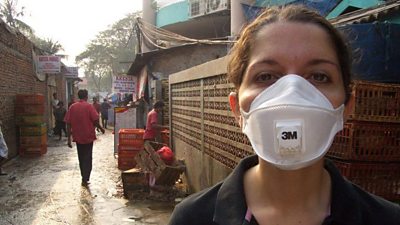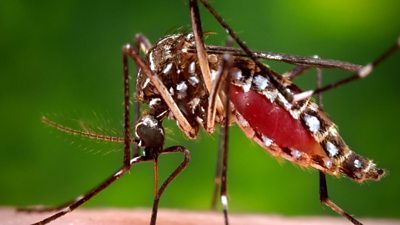Note this is a developing situation and the information in this page may change or be added to as the disease and/or knowledge about the current outbreak evolves.
What Can Go Wrong?
- Mpox transmission could occur between staff, freelancers, contributors and/or other contacts.
- Staff, contributors or other contacts at higher risk of serious illness could contract the disease.
- ���˿��� staff or freelancers could spread the virus to others.
Legal/Travel/���˿��� Requirements
- Research and follow local public health protocols and restrictions that may be in place to prevent spread of Mpox.
- Some countries may have mpox screening in place. Check FCDO foreign travel advice () for entry requirements of the country you are travelling to.
- Workers travelling from the UK to a country affected by will need to engage with the UKHSA Returning Workers Scheme ().
- Contact the before travel, for further direction. See also UKHSA Clade 1 information document under 'useful docs' below
- Carry out a deployment risk assessment if covering the story or travelling to areas with a high background risk of transmission.
- Consider people at higher risk of serious illness from Mpox and follow the advice given on this page.
Control Measures
Risk assessment
- A separate risk assessment will be required if deploying to cover the Mpox story, or if deploying to areas with high background risk of Mpox.
- News teams should use PTK pages to check risk classification of areas that may be deployed to and if necessary speak to HRNS to confirm which type of risk assessment is therefore required.
Categorisation of risk
- Mpox deployment risk will fall into one of the 3 categories listed below. Decide which category applies and consider all of the generic controls given.
- Teams will need to tailor the controls to fit the specific circumstances of the deployment.
- Category 1 will apply to ALL deployments.
- Categories 2 and 3 should be considered only if editorially necessary and after consultation with editorial team leader and HRNS.
All Locations – Category 1
- Team is aware and understands published health advice from trusted authorities on Mpox symptoms, transmission and self-care. Some references below from WHO, NHS and Africa CDC:
- If travelling from the UK you may need to enter the UKHSA returning workers scheme – Refer to the Legal/Travel/���˿��� Requirements above.
- Identify whether location has a higher risk profile for mpox, eg crowded locations such as refugee camp.
- Seek information on and cooperate with infection control protocols in host location.
- All team members should have valid medical insurance for any necessary treatment.
- Follow general infection control procedures:
-
Keep at least 1m distance.
- Where possible, conduct interviews outdoors.
- Avoid shared touchpoints and avoid sharing hygiene items, eating utensils and water bottles.
- Avoid touching clothing, bedding or possessions of individuals.
- Avoid contact with animals.
- Avoid eating or touching meat from wild animals.
- Wash hands thoroughly and regularly, or use hand sanitiser with at least 60% alcohol.
- Post deployment, clean any textiles, equipment or surfaces of concern. See
- Where accessible, any teams deploying to areas with risk of Mpox should consider having the vaccine.
- Be aware of and monitor for symptoms post deployment for 21 days.
- Team should avoid direct contact with higher risk individuals e.g. pregnant women, those with underlying health conditions, after deployment.
- Follow local public health advice for isolation and contact tracing if symptoms develop.
- Seek further advice from ���˿��� team leader.
Community Deployments: Suspected/confirmed cases of Mpox - Category 2
- Public Health advice is that individuals in this category should be isolating.
- For managed locations, seek information and assurance on local protocols in place to prevent spread.
- Avoid entering isolation area where possible.
- If entry is necessary, full PPE as per clinical setting should be worn with a clear plan for safe disposal. See
- Discuss deployment with HRNS prior to risk assessment.
Clinical Settings: Treating Mpox patients - Category 3
- Seek information and assurance from the health provider on local protocols for authorised access and infection control.
- Follow direction of the host on PPE. It is expected this will include : gloves, mask, gown and eye protection. For further information see .
- Source PPE in use to specified type and standard
- Expected minimum standard for mask is N95 or FFP2/3.
- Follow exert advice on how to properly fit and wear PPE.
- Follow expert advice on how to safely dispose of PPE.
- Discuss deployment with HRNS prior to risk assessment.
Hygiene
-
Encourage team members and contributors to wash hands regularly with soap and water, or to regularly use hand sanitiser at least 60% alcohol if unable to wash hands.
-
Be aware that transmission occurs through close contact and have a plan in place to:
- avoid touching shared contact points where possible and;
- clean any equipment or surfaces of concern;
- launder any clothing or textiles of concern.
- For further information see .
- Consider use of boom or fixed microphones over lapel/personal mics.
- For shared broadcast equipment, e.g. radio mics, ear pieces, follow a standard cleaning and hygiene protocol to reduce risk of transmission.
Contributors and other impacted persons
- Check whether anyone is at higher risk of serious illness from Mpox, or is living with someone in this category.
PPE
- Where PPE is assessed to be necessary for a deployment the risk assessment should specify type and standard of PPE, eg N95/FFP3 mask.
- Team should be briefed on correct fitting and use of any PPE identified in the risk assessment.
- Where PPE is worn, a clear plan for safe laundering, cleaning and/or disposal must be considered as part of the risk assessment.
What to do if concerned about Mpox symptoms
• Staff and freelancers should monitor for Mpox symptoms for 21 days after deployment.
• Avoid direct contact with higher risk individuals e.g. pregnant women, those with underlying health conditions.
• Follow local public health advice for notification, isolation and contact tracing if symptoms develop.
• Speak to your ���˿��� team leader, who should seek further advice through HRNS.
Key Actions
- If your deployment is not high risk, record your risk assessment on the Safety Hub.
- If you deployment is high risk, follow the usual process for high risk assessment, engaging with HRNS at the earliest opportunity.
Division Specific Issues
- As covered above
FAQs/Did You Know?
Useful documents
-
Clade I mpox: Information for humanitarian aid and other workers intending to work in Clade I mpox affected countries
-
Gateway only
-
Gateway only
-
Mpox notes (2024) by Chris Gibson BSc(Hons) MSc FAWM WP-C MCPara
Recommended links
Disease-specific topics
-

Bird Flu
Advice for staff covering the outbreak of avian 'flu in Yorkshire in 2014 -

Living with Coronavirus (Covid-19) – advice for staff
Advice for staff about travel and/or interviewing guests -

Disease and Contact with Viruses and Bacteria
A guide for anyone deployed to areas where there is risk from infectious disease from human, animal, insect or parasite sources, including zoonoses. These controls can also apply to harmful bacteria found in incidents such as sewage spills. -

Ebola Virus Disease (EVD)
Ebola is a contagious and often fatal illness which has had periodic outbreaks in the DRC and Sudan. -

Influenza ('Flu)
A guide to influenza, or 'flu', for individuals seeking general advice or during an epidemic or pandemic situation. -

MERS: Middle East Respiratory Syndrome
This is a virus that is new to humans and was first identified in Saudi Arabia in 2012. -

Mpox (monkeypox)
Requirements to be met for Mpox (2024) outbreak coverage and/or travelling to work in areas where there are high reported cases of Mpox. -

Zika Viral Disease
Zika Viral Disease is a mosquito-borne disease caused by the Zika virus. In 2015, the World Health Organisation declared it a global public health emergency.
More from SSR
-
Your platform to record accidents, risk assessments, assurance monitoring and inspections
-
Safety Equipment Stores
Just one number to call: 020 3614 5155 -
���˿��� Safety Guidelines
An A-Z of ���˿���'s Health and Safety Guidelines -
Safety Advice Line: 0370 411 0464 Email: safety@bbc.co.uk
- A-Z of ���˿��� Safety Guidelines
- Accident Reporting and Investigation
- ���˿��� Health & Safety Policy
- Contractors (incl. vetted lists)
- Contributors
- Fire Safety
- Freelancers
- Independent Production Companies
- Risk Assessment
- Safety Alerts
- Safety Responsibilities
- Safety Training
- Sets & Premises Safety Guide
Events guidance - key links:
- Exhibitions
- General Guidance
- Indoor Location Recce Checklist
- Outdoor Location Recce Checklist
- Major Incidents & Emergency Planning
- Marketing and Promotional
- Noise Exposure
- Planning and Management
- Responsibilities
- Responsibilities Form
- Laser Lighting Effects
- Strobe Lighting
- Temporary Stages and Rostra
Health topics - key links:
- (���˿��� network only)
- Contributors Fitness to Participate
- Display Screen Equipment (DSE)
- (���˿��� network only)
- First Aid and Welfare on Location
- International Travel - Risks & Health
- Manual Handling
- Mental Health: ���˿���page
- (���˿��� network only)
- Personal Health and Wellbeing
- Pregnancy
- Psychological Trauma Support & Trauma Risk Management (TRiM)
- Tiredness and Fatigue
- Travel Health Contacts
���˿��� High Risk - key links:
- CBRN and Industrial Spills
- Covert Filming
- Crisis Management and Security Support
- Demonstrations, Protests and Crowds
- Disaster Coverage
- Door Stepping
- (���˿��� network only)
- (���˿��� network only)
- Public Order
- Safety Equipment Stores
���˿��� Journalism - key links:
���˿��� Productions - key links:
- Aerial Filming and Airfields
- Animals: Displaying and handling for performance
- Boats: Working on
- Children and Young People
- Driving
- Electrical Equipment and Systems
- First Aid and Welfare on Location
- Food Safety (Cooking and Catering)
- Remote Location Working
- Roads and Streets: Working by
- Security of Productions on Location
- Stunts
- Tiredness and Fatigue
- Unmanned Aerial Systems (UAS aka Drones)
- Vehicles: Recording in, from and around
- Working at Height: Mobile Elevating Work Platforms
- Working at Height: Tower Scaffolds
���˿��� Radio - key links:
- (���˿��� Network only)
���˿��� Security - key links:
���˿��� Sport - key links:
About this site
This site describes what the ���˿��� does in relation to managing its health, safety and security risks and is intended for those who work directly for the ���˿���.
It is not intended to provide instruction or guidance on how third parties should manage their risks. The ���˿��� cannot be held liable for how this information is interpreted or used by third parties, nor provide any assurance that adopting it would provide any measure of legal compliance. More information
Some links on this site are only accessible when connected to the ���˿��� network
